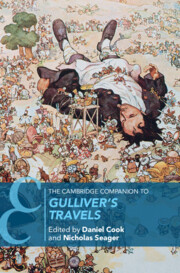Book contents
- The Cambridge Companion to Gulliver’s Travels
- The Cambridge Companion to Gulliver’s Travels
- Copyright page
- Contents
- Figures
- Notes on Contributors
- Abbreviations
- Note on the Text
- Chronology
- Introduction
- Part I Contexts
- Part II Genres
- Chapter 5 Popular Fiction
- Chapter 6 Satire
- Chapter 7 Travel Writing
- Chapter 8 Philosophical Tale
- Part III Reading Gulliver’s Travels
- Part IV Afterlives
- Further Reading
- Index
- Cambridge Companions to Literature
Chapter 5 - Popular Fiction
from Part II - Genres
Published online by Cambridge University Press: 05 October 2023
- The Cambridge Companion to Gulliver’s Travels
- The Cambridge Companion to Gulliver’s Travels
- Copyright page
- Contents
- Figures
- Notes on Contributors
- Abbreviations
- Note on the Text
- Chronology
- Introduction
- Part I Contexts
- Part II Genres
- Chapter 5 Popular Fiction
- Chapter 6 Satire
- Chapter 7 Travel Writing
- Chapter 8 Philosophical Tale
- Part III Reading Gulliver’s Travels
- Part IV Afterlives
- Further Reading
- Index
- Cambridge Companions to Literature
Summary
In Gulliver’s Travels Swift tacitly drew his first readers’ attention to two forms of popular fiction: imaginary voyages in the manner of Lucian’s True History, and the pseudo-autobiographical fictitious travellers’ tales made familiar by The Life and Strange Surprizing Adventures of Robinson Crusoe, of York, Mariner, ‘Written by Himself’. Contemporaries recognised the rhetorical similarities between the True History and Swift’s ironic manner, and there are clear plot resemblances. There is also evidence that contemporaries associated Gulliver’s Travels with the pseudo-autobiographical narratives made popular by Defoe, perhaps because Swift included the same sort of circumstantial autobiographical detail. Whether this makes Gulliver’s Travels a ‘parodying novel’ is an interesting question. It was routinely included in lists of novels in the century following its initial publication, which suggests that eighteenth-century readers had no difficulty appreciating that, if Gulliver’s Travels was not a novel, it was unquestionably working within a recognisable popular literary tradition.
- Type
- Chapter
- Information
- The Cambridge Companion to Gulliver's Travels , pp. 61 - 72Publisher: Cambridge University PressPrint publication year: 2023

